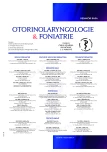Computational Fluid Dynamics of Nasal Airflow Under Physiological Conditions - First Experience
Authors:
M. Plášek 1,2; M. Bojko 3; P. Koblížková 1; Pavel Komínek 1,2; Petr Matoušek 1,2
Authors‘ workplace:
Klinika otorinolaryngologie a chirurgie hlavy a krku, Fakultní nemocnice Ostrava
1; Katedra kraniofaciálních oborů, Lékařská fakulta, Ostravská univerzita v Ostravě
2; Katedra hydromechaniky a hydraulických zařízení, Fakulta strojní, Vysoká škola báňská - Technická univerzita Ostrava
3
Published in:
Otorinolaryngol Foniatr, 68, 2019, No. 4, pp. 199-203.
Category:
Original Article
Overview
Introduction: The pattern of the nasal airflow is crucial for normal nasal breathing as well as it can be a pathophysiological underlay of nasal symptoms (nasal obstruction, crusting etc). It is difficult to define one physiological airflow pattern because subjective symptoms of patients do not correlate with objective findings quite often. Nowadays, the computational fluid dynamics (CFD) is dominant way how to simulate and study nasal airflow.
Methods: For nasal airflow simulation 3D model of nasal cavity was created according to CT scans of nasal cavity (patient had no problems with nasal breathing). The 3D model was created with the cooperation with Technical University of Ostrava.
Results: Our first experience with CFD showed that there is a different airflow pattern between right and left nasal cavity. Major part of airflow was detected in inferior and inferior part of common meatus and also in the middle and in the middle part of common nasal meatus. These results support studies that declare differences in nasal aerodynamics among healthy adults.
Conclusion: CFD has a potential to be used in clinical practice especially in functional rhinosurgery.
Keywords:
computational fluid dynamics – 3D model – nasal airflow
Sources
1. Bojko, M., Kozdera, M., Kozubková, M.: Investigation of viscous fluid flow in an eccentrically deposited annulus using CFD methods. EPJ Web of Conferences, 45, 2013, s. 1-6.
2. Bojko, M., Kocich, R.: CFD analysis of the plate heat exchanger - Mathematical modelling of mass and heat transfer in serial connection with tubular heat exchanger. AIP Conference Proceedings, 1745, 2016, 1, s. 1-4.
3. Chometon, F., Ebbo, D., Gilléron, P. et al.: A numerical simulation of the aerodynamics of the nasal cavity. Ann Otolaryngol Chir Cervicofac, 117, 2000, 2, s. 98-104.
4. Grützenmacher, S., Lang, G., Mlynski, G.: Flow simulation, rhinoresistometry and acoustic rhinometry in nasal models before and after turbinate surgery. 65, ORL, 2003, s. 341-347.
5. Keyhani, K., Scherrer, P., Mozzel, M.: Numerical simulation of airflow in the human nasal cavity. J Biomech Eng, 117, 1995, 4, s. 429-441.
6. Kozubková, M., Blejchař, T., Bojko, M.: Modelování přenosu tepla, hmoty a hybnosti, VŠB TUO, 2011, s. 174.
7. Mlynski, G., Grützenmacher, S., Plontke, S.: A method for studying nasal airflow by means of fluid dynamics experiments. Z Med Phys, 10, 2000, 3, s. 207-214.
8. Mlynski, G., Grützenmacher, S., Plotnke, S. et al.: Correlation of nasal morphology and respiratory function. Rhinology, 39, 2001, 4, s. 207-214.
9. Önerci, T., Shimzu, T., Mlynski, R. et al.: Nasal physiology and pathophysiology of nasal disorders. Springer-Verlag Berlin Heidelberg, 2013, s. 280-300, 323-356.
10. Plášek, M., Matoušek, P., Komínek, P. et al.: Proudění vzduchu nosem za fyziologických a patologických stavů. Otorinolaryng a Foniat /Prague/, 67, 2018, 4, s. 113-118.
11. Simmen, D., Heinz, B., Moe, K. et al.: A dynamic and direct visualization model for the study of nasal airflow. Arch Otolaryngol Head Neck Surg, 125, 1999, 9, s. 1015-1021.
12. Weinhold, I., Mlynski, G.: Numerical simulation of airflow in the human nose. Eur Arch Otolaryngol, 261, 2004, 2, s. 452-455.
13. Zborayová, K.: Nosní obstrukce - objektivizace a možnosti léčebného ovlivnění. Disertační práce, Hradec Králové, 2009.
14. Zhao, K., Jiang, J.: What is normal nasal airflow. A computational study of 22 healthy adults. Int Forum Allergy Rhinol, 4, 2014, 6, s. 435-446.
15. Zhao, K., Dalton, P.: The way the wind blows: implications of modeling nasal airflow. Curr Allergy Asthma Rep, 7, 2007, 2, s. 117-125.
Labels
Audiology Paediatric ENT ENT (Otorhinolaryngology)Article was published in
Otorhinolaryngology and Phoniatrics

2019 Issue 4
Most read in this issue
- Video Head Impulse Test, závrať, vestibulární neuronitida, vestibulární vyšetření, učební křivka
- Bilateral Peritonsillar Abscess
- Primary Vasculitis in Otorhinolaryngology: Review of the Literature and Case Reports
- Balloon Eustachian Tuboplasty in Treatment of Chronic Otitis Media with Effusion
